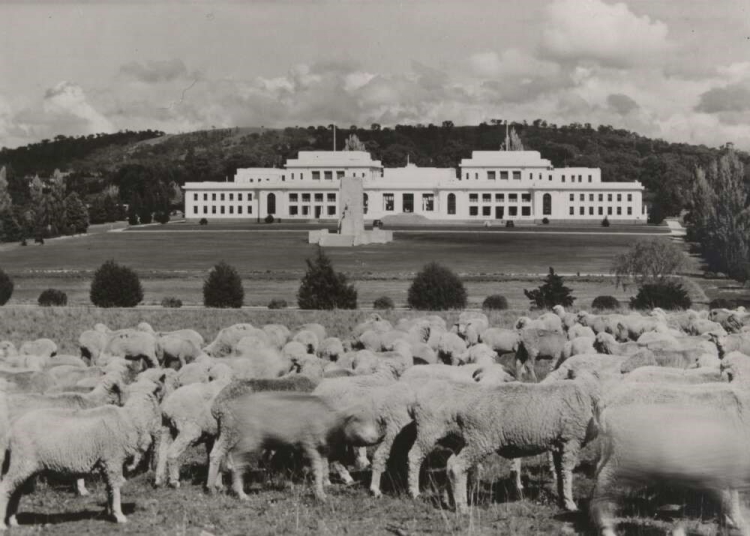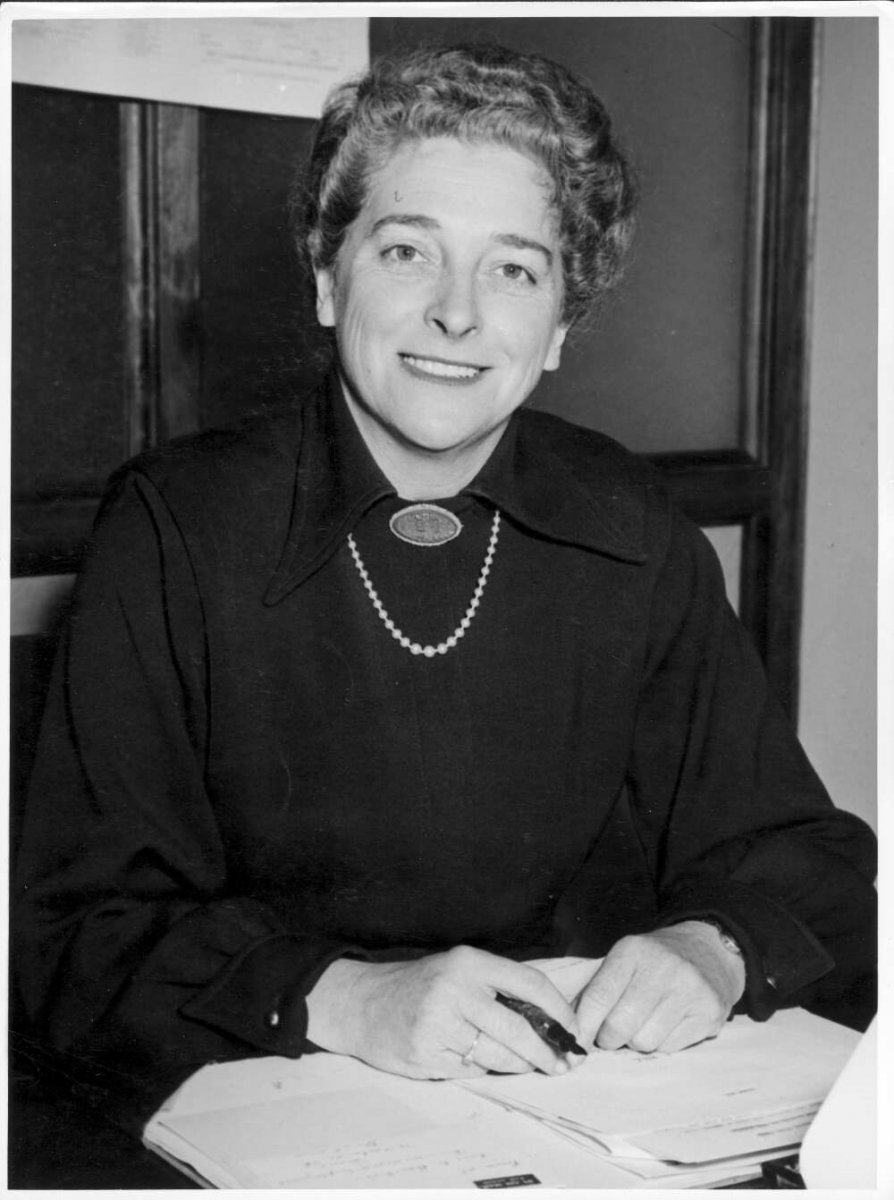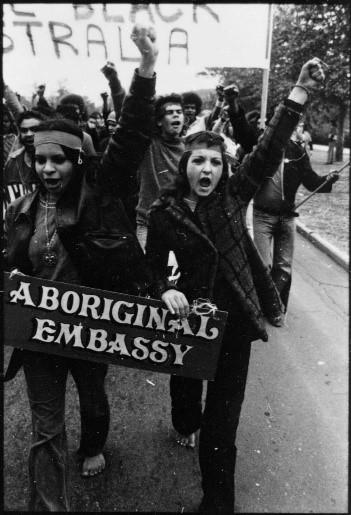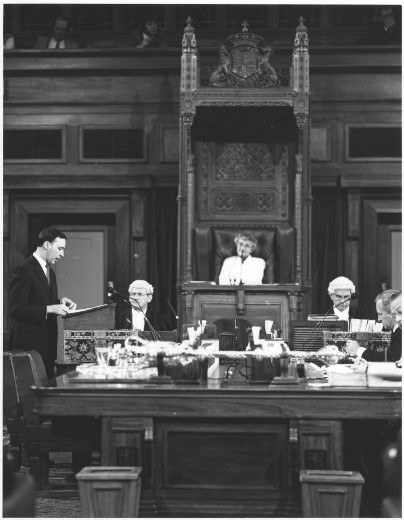On 9 May 2021, Old Parliament House celebrated it’s 94th birthday and I have been pondering it’s history in connection with women and Parliament. I have been slowly reading Professor Clare Wright’s You Daughters of Freedom, which is about the women, ‘who won the vote and inspired the world’. I say slowly reading, because I have been pausing after the introduction of each new player to investigate the primary sources for myself. I recommend reading or listening to Professor Clare Wright’s author talk on her book here.
With these procrastinations away from the book into the National Library’s collections, and with recent events in Australia’s political and cultural life, I have been turning to our history for inspiration and consolation, and for reading about Australian woman who were ‘first’. So, as I move from my introduction to one of my favourite ‘first women’, here is my second favourite photograph of the birthday building, Old Parliament House, surrounded by sheep.

Robert Strangman (1895-1969), Old Parliament House, Canberra, with Sheep in Foreground, 194-?, nla.cat-vn3773044
‘First Woman’ Dame Annabelle Jane Rankin
In last year’s Old Parliament House birthday blog post, I introduced you to the two ‘first women’ elected to Federal Parliament in 1943, Dame Enid Lyons and Dame Dorothy Tangney. Following hot on their heels to achieve more firsts was Dame Annabelle Jane Rankin (1908-1986), who, in September 1946, won a Queensland Senate seat for the Liberal-Country Party becoming the first woman to represent the Sunshine State in Federal Parliament.
The first thing I always do when researching prominent Australians is see if the National Library’s clippings team have compiled a folder of newspaper clippings on said prominent Australian. The first article in Dame Annabelle’s clippings folder is from The Sunday Mirror, 20 January 1966, and is titled ‘The Minister Wore Pearls’. It is an interview by a sartorially elegant Diana Ward with Dame Annabelle Rankin on the occasion of her appointment as ‘the first woman to take on the responsibility of a Federal Government department’ as minister for housing. Ms Ward described our first female minister as a woman of:
unfussy efficiency, clarity of thought and ability for determined hard work…As a bonus, Dame Annabelle’s sense of humour and warm interest in people should help to ease some of the problems she is sure to encounter in the realm of housing…a commodity dear to the heart of most Australians.

Portrait of Senator Annabelle Rankin, 195-?, nla.cat-vn1593706
These were not the only firsts for Dame Annabelle. Fresh to Parliament in 1947, she became not just the first female government whip in Australia, but the first in the British Commonwealth. In a 28 July 1969 Woman’s Day interview, ‘the Liberal’s No. 1 vote-getter in Queensland’ remarked that to be a successful government whip one must have:
the patience of Job, the wisdom of Solomon and the diplomacy of the most diplomatic person ever – none of which I’ve got. It’s a very exacting job. You have to ensure the numbers for all your votes. No one can have leave without your permission. You must endeavour to get your people to vote for the Government legislation, and you have some who don’t always want to.
Dame Annabelle Rankin became a Dame Commander of the British Empire in 1957. When she retired from politics in 1971, I think she must have thought, ‘Maybe one more ‘first’ before I retire?’ as she then went on to serve as the high commissioner to New Zealand from 1971 to 1974, being the first female to do so. Dame Annabelle was a politician for all Australians, but she saw the role of women as voters, citizens and parliamentarians as an integral part of the political process. As she said in the aforementioned Woman’s Day interview:
I think the women’s vote shows itself on anything that affects general living. After all, everything that happens in Parliament affects women in some way or other. I always say: “Legislation goes into your home”.
She didn’t see herself as a feminist, but her political career—a career of ‘firsts’—proved that women could and should be active participants not just in our parliaments, but in every aspect of Australian democracy. She led by example and she inspired by example.
It seems to me you make a choice and set a course in life and if you are working on those lines you haven’t time to protest.
Alas, despite the inspiring examples of our ‘first women’, today’s feminists know that political nous only gets you so far and that sometimes a protest is needed for women’s voices to be heard.
As you visit Old Parliament House during its 94th year, do think about Dame Annabelle Rankin and our other ‘first women’, not only those from our Federal Parliament, but also those in the state, territory and local iterations, who served and legislated for us. Go exploring the National Library catalogue to learn more about our ‘first women’ of Old Parliament House and the ‘daughters of freedom’ who were part of our journey to become the Commonwealth of Australia, and the first country to allow women to stand for parliament.

Ken Middleton (b.1948), Two Unidentified Women Marching with a Banner at the Aboriginal Land Rights Demonstration, Parliament House, Canberra, 30 July 1972, nla.cat-vn5781359

Michael Jensen (b.1943), Paul Keating, Prime Minister of Australia 1991-1996, Addressing the House of Representatives, Old Parliament House, Canberra, [198-?], nla.cat-vn3298694
Further reading (and listening) on our first women
Browne, Waveney, A Woman of Distinction: the Honourable Dame Annabelle Rankin D.B.E. Ascot, Qld: Boolarong Publications,1981, nla.cat-vn54732.
Child, Joan, and Johnstone, Graeme, Joan: Child of Labor. Cromer, Victoria: Graeme Johnstone, 2015, nla.cat-vn6927819.
Joan Child Interviewed by Susan Marsden in the Old Parliament House Political and Parliamentary Oral History Project, 2009, nla.cat-vn4729825.
Margaret Guilfoyle Address to the National Press Club on 17 November 1977 [sound recording], nla.cat-vn148675.
Papers of Margaret Reid, 1969-2003, nla.cat-vn4252002.
Ryan, Susan, Catching the Waves: Life In and Out of Politics. Pymble, NSW: HarperCollins, 1999, nla.cat-vn2840266.